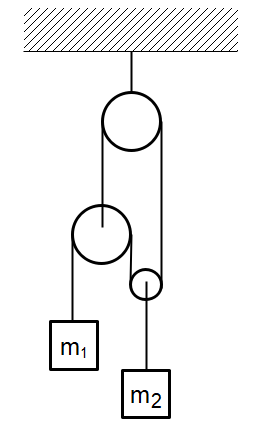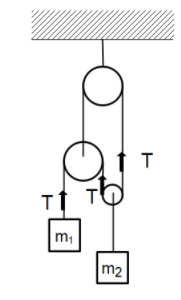
Pulley mass system is shown in figure string and pulleys and strings are ideal. Acceleration of \[{m_2}\] and ${m_1}$ will be:

A) ${a_1} = 2{a_2}$
B) ${a_1} = 2{a_1}$
C) ${a_1} = {a_2} = g$
D) ${a_1} = 3{a_2}$
Answer
217.8k+ views
Hint: In this solution, we will draw the free body diagram of the string pulley system. Then we will calculate the tension in the strings to calculate the acceleration in the two blocks.
Complete step by step answer:
Let us start by drawing a free body diagram of the tension in the different strings.

AS we can see, for the mass ${m_1}$ the mass it experiences is associated with only the bottom left pulley. Hence, we can write the equation of motion for the first mass as:
$T = m{a_1}$
Now the string connecting the lower two pulleys is the same so the net displacement will be zero. Also, we can see that for the pulley in the bottom right, the tension in the two strings will be $2T$ as can be seen from the diagram. Also, the tension in the string can be represented as the acceleration of the object which will be
$T = 2m{a_2}$
Since the tension will be the same in the string for both the bottom pulleys, we have
$m{a_1} = 2m{a_2}$
So, the relation of the acceleration of the two blocks will be
${a_1} = 2{a_2}$
Hence the correct choice will be choice (A).
Note: We can intuitively expect the first mass to have higher acceleration since it will have to compensate for the tension exerted by the other mass as it is connected by two pulleys. As a result, the displacement of the first block will always be higher than the displacement of the second block. We shouldn’t worry about the movement of individual pulleys but only the tension in the strings as it simplifies our calculations.
Complete step by step answer:
Let us start by drawing a free body diagram of the tension in the different strings.

AS we can see, for the mass ${m_1}$ the mass it experiences is associated with only the bottom left pulley. Hence, we can write the equation of motion for the first mass as:
$T = m{a_1}$
Now the string connecting the lower two pulleys is the same so the net displacement will be zero. Also, we can see that for the pulley in the bottom right, the tension in the two strings will be $2T$ as can be seen from the diagram. Also, the tension in the string can be represented as the acceleration of the object which will be
$T = 2m{a_2}$
Since the tension will be the same in the string for both the bottom pulleys, we have
$m{a_1} = 2m{a_2}$
So, the relation of the acceleration of the two blocks will be
${a_1} = 2{a_2}$
Hence the correct choice will be choice (A).
Note: We can intuitively expect the first mass to have higher acceleration since it will have to compensate for the tension exerted by the other mass as it is connected by two pulleys. As a result, the displacement of the first block will always be higher than the displacement of the second block. We shouldn’t worry about the movement of individual pulleys but only the tension in the strings as it simplifies our calculations.
Recently Updated Pages
Arithmetic, Geometric & Harmonic Progressions Explained

Cartesian Form of Vector Explained: Formula, Examples & Uses

Apparent Frequency Explained: Formula, Uses & Examples

Calorimetry: Definition, Principles & Calculations

Centrifugal Force Explained: Definition, Formula & Examples

Charge in a Magnetic Field: Definition, Formula & Examples

Trending doubts
JEE Main 2026: Application Form Open, Exam Dates, Syllabus, Eligibility & Question Papers

Derivation of Equation of Trajectory Explained for Students

Hybridisation in Chemistry – Concept, Types & Applications

Understanding the Angle of Deviation in a Prism

Understanding Collisions: Types and Examples for Students

Understanding Atomic Structure for Beginners

Other Pages
JEE Advanced Marks vs Ranks 2025: Understanding Category-wise Qualifying Marks and Previous Year Cut-offs

Units And Measurements Class 11 Physics Chapter 1 CBSE Notes - 2025-26

NCERT Solutions For Class 11 Physics Chapter 8 Mechanical Properties Of Solids

Motion in a Straight Line Class 11 Physics Chapter 2 CBSE Notes - 2025-26

NCERT Solutions for Class 11 Physics Chapter 7 Gravitation 2025-26

How to Convert a Galvanometer into an Ammeter or Voltmeter




